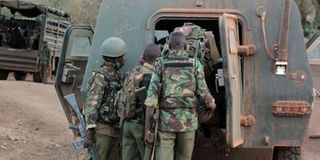Community policing best way to end killings

Police board an Armoured Personnel Carrier in Baringo County on March 15, 2017, where they were sent to restore order. A more effective solution would be to strengthen community policing. PHOTO | CHEBOITE KIGEN | NATION MEDIA GROUP
What you need to know:
- The difficulty faced by the security agencies can largely be attributed to the lack of cooperation with the local communities in the region.
- The goals of community policing significantly deviate from the military goal of seeking out and destroying the enemy.
The increased cases of killings, deaths and run-away arson in the North Rift over the past few weeks led to the deployment of the Kenya Defence Forces to restore law and order.
The move, however, raises pertinent questions. What is the capacity of the police to thwart lawlessness in Baringo, West Pokot, Elgeyo Marakwet and Laikipia counties?
What has been the effect of community policing in preventing such violence in the region?
While community policing draws heavily on the importance of relationships between the police and the community, the concurrent deployment of military in such situations may be undermining those relationships.
ADEQUATE RESOURCES
The government has increased efforts to tackle insecurity in the North Rift region.
It has deployed additional security agents and increased resources allocated to the security agencies.
With the elections fast approaching, the government has in addition to ordering the deployment of KDF forces and 255 Kenya Police Reservists (KPRs) in the Kerio Valley, unveiled modern police vehicles including mine-resistant personnel carriers and armoured personnel carriers, as part of a modernisation programme for the police that has seen the deployment of 2,200 police vehicles in the first two phases.
SOUR RELATIONS
However, these efforts are unlikely to be more effective than those before it.
This is because they do not address the perennial problem causing insecurity in the region — lack of community involvement.
The difficulty faced by the security agencies can largely be attributed to the lack of cooperation with the local communities in the region.
The security agencies have faced strong retaliation from raiders and have themselves been targeted, the worst being the Baragoi and Kapedo police massacres in 2012 and 2014 respectively.
The goals of community policing significantly deviate from the military goal of seeking out and destroying the enemy.
PROPER TACT
Studies show that militarisation not only causes a civilian-police strain but also causes the civilians to see police as an enemy.
The use of military equipment by the police, under the modernisation programme, is not policing but a form of militarisation.
A more effective solution would be to strengthen community policing.
The community policing model takes a progressive approach aimed at reducing crime and making communities safer.
This is achieved through law enforcement officials involving the communities and seeking their assistance to monitor and prevent crime, especially through crime reporting.
THE SOLUTIONS
However, the community policing model needs to be strengthened for better implementation.
First, the National Task Force on Community Policing ought to ensure that the concept of community policing in the Kenyan context is clarified and the roles of different players properly outlined.
Second, the institutional capacity to implement community policing initiatives should be strengthened through provision of adequate resources.
Moreover, a performance measurement framework for police officers should be developed to measure the quality of their engagement with the community.
In light of the search for sustainable solutions to insecurity in the North Rift and other regions, investment in community policing is a more productive use of resources.
Community involvement in security is, in addition to being a constitutional requirement, an indispensable asset to security agents.
Brian Kimari and Joash Moitui are Junior Research Fellows at the Centre for Human Rights and Policy Studies




